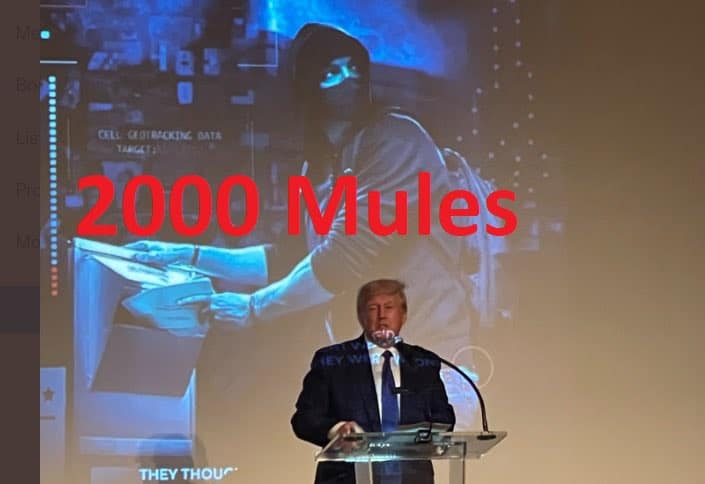I teach a course on modern American conspiracies at Kutztown University. One of the fundamental concepts that we develop is the need to match claims with evidence. Any legitimate argument must have both features working in concert. In fact, as I tell my students, the more evidence the better. “The bigger the claim, the bigger the proof,” is our mantra. If we can cross reference valid information and allow for layers of corroboration, the better we serve the original claim. All of this is part of a process that applies to any discussion regardless of liberal, moderate, or conservative standing.
My classes also talk about the reality that 100 percent certainty of anything is almost impossible. We understand that the threshold is defined when a reasonable person might be convinced that a claim makes sense. Teaching this process is what good faculty do for a living, something I have attempted for the last 27 years.
Unfortunately, Dinesh D’Souza’s “2000 Mules” contains none of the features mentioned above, more specifically a clear chain of evidence, a logical process, basic due diligence, or good faith.
“2000 Mules” starts with a very big claim: that the 2020 presidential election was stolen by a national network of operatives (both unnamed non-profits and their anonymous “mules”) who transported thousands of illegal ballots from “stash houses” and submitted them in drop boxes in a series of key battleground states like Georgia, Pennsylvania, and Wisconsin, among others.
Such a massive claim definitely begs evidence of equal proportion. To accomplish this task, D’Souza brings in the conservative non-profit True the Vote, which carries the investigation forward with a deep dive into both geotracking data obtained from the cell phones of the alleged “mules,” in addition to over 4 million minutes of video footage of the drop boxes in question. The production values in “2000 Mules” – lighting, editing, graphics, and urgent background music—are all first rate. With the addition of experts from institutions like the Heritage Foundation and the American Enterprise Institute, along with a series of political analysts, it has all the makings of a legitimate documentary.
But appearances can be very deceiving. Despite its slick style, the evidence offered by “2000 Mules” has serious shortcomings. The first problem involves the cell phone tracking data. A number of computer science experts have questioned the idea that the data is an accurate “fingerprint” (D’Souza’s term) regarding individual movement. More importantly, True the Vote produced exactly one map that recorded one individual’s travels near 28 drop boxes and five unnamed organizations in the Atlanta area, which D’Souza identifies as “stash houses” in the film. No other details follow. Despite the cell phone data “fingerprint,” the viewer gets no additional facts regarding the person’s identity, affiliation, or purpose for traveling. At no point does “2000 Mules” provide basic information like identifying the alleged “stash houses,” their leadership, or even a street address.
READ: Bucks County GOP Chair Pat Poprik Named In ‘Insurrection Index’
The same problems emerge with respect to the 4 million minutes of video taken at drop boxes. The viewer gets to see a series of individuals dropping off multiple ballots at places that lack timestamps or location information. D’Souza provides some of these in his narration, but it is not consistent. Despite the apparently massive amount of footage, the video evidence establishes no patterns of movement for either individuals or the mysterious non-profits. There are lost opportunities here. While much of the video data covers Atlanta, “2000 Mules” does not follow the person who visited the 28 drop boxes to corroborate the geotracking data submitted early in the film. It is an odd omission. Instead, D’Souza and a number of pundits focus on the seemingly odd behavior of people wearing surgical gloves (during a pandemic) when they visited individual drop boxes.
More disturbing is the fact that when it is not content to use video footage culled from official sources, “2000 Mules” simply intercuts its own fabrications with real evidence. Obviously re-enacted scenes of “operatives” taking ballots out of mailboxes, delivering them to other conspirators, or placing them in drop boxes are interspersed throughout the movie. The most obvious tip-off is footage that D’Souza somehow obtained from inside the cars driven by the “mules.” All the recreations are filmed in a desaturated color format clearly designed to resemble the official video. The quality of the editing is impressive. The deception it promotes is deeply problematic.
This type of consistent fakery is an ironic counterpoint to a film about election fraud, but it points to a deeper thread of bad faith that appears throughout “2000 Mules.” For example, when D’Souza convenes a panel of conservative pundits to address alleged fraud in Georgia, Charlie Kirk comments that state law permits only individuals to drop off their own ballots or those of family members. This statement is simply untrue, but it goes unquestioned during the exchange. The absence of any real challenges to the premise regarding the 2020 election is an ongoing case study in confirmation bias – the tendency to seek out information that confirms a pre-existing belief – and one that took a strange twist during “2000 Mules.”
The case in question involved deliberate election fraud committed by Republican Mark Harris during the 2018 North Carolina 9th District Congressional election. Early in the film, “2000 mules” uses the scandal to establish Right the Vote’s non-partisan status, although it is not clear if they had any role in uncovering the scandal.
The North Carolina scandal reappears towards the end of the film, but in a much different context. D’Souza invites Hans van Spakovsky, a senior fellow at the Heritage Foundation to assess the problem of election fraud in America and he obliges, flatly stating that most cases of election originate with the Democrat Party. A few minutes later, 2000 Mules then segues seamlessly to an example, and an apparent bombshell takes the viewer right back to the North Carolina 9th District. This time, however, D’Souza makes no mention of the Republican implicated in the scandal. Instead, the film reverts to a series of generalizations about the vulnerability of absentee ballots, actual local news footage from North Carolina, interspersed again with more recreated footage. At no point does D’Souza or his Heritage Foundation expert acknowledge any of the state laws that administer or secure absentee votes. They also ignore states like Florida, which is notable for its flexible policies for early voting, absentee ballots, and third party delivery of votes to drop boxes. The reason could be very simple: Trump won Florida in 2020.
READ: Five Stories Gannett’s Bucks County Courier Times Refuses To Cover, But Should
Historians have seen this methodology before. Senator Joseph McCarthy was a master at making false correlations, also known as guilt by association, during the depths of the Red Scare. “2000 Mules” borrows these basics and simply augments them with better production values, but it is a process designed to appeal to an audience ready to accept a quick gloss rather than address the underlying facts or basic logic. Our job as educators will be to introduce audiences to this type of demagoguery with the same question: do the claims match the proof? In the case of “2000 Mules,” the answer is definitely no.







